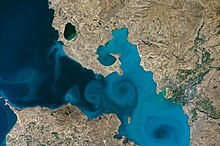File:ISS049-E-003464 (Van Lake).jpg
ISS049-E-003464_(Van_Lake).jpg (720 × 480 pixels, file size: 357 KB, MIME type: image/jpeg)
Captions
Captions
Summary
[edit]| DescriptionISS049-E-003464 (Van Lake).jpg |
English: An astronaut aboard the International Space Station captured this photograph of part of Lake Van in Turkey, the largest soda or alkaline lake on Earth. Generally, soda lakes are distinguished by high concentrations of carbonate species. Lake Van is an endorheic lake—it has no outlet, so its water disappears by evaporation—with a pH of 10 and high salinity levels.
Waters near the city of (population 90,000) are shallow, but other parts of the lake can be up to 450 meters (1,467 feet) deep. Lake Van water levels have changed by 100s of meters over the past 600,000 years due to climate change, volcanic eruptions, and tectonic activity. Turbidity plumes, which appear as swirls of light- and dark-toned water, are mostly comprised of calcium carbonate, detrital materials, and some organic matter. High particle fluxes occur in Lake Van during spring and fall, when phytoplankton and aquatic plants grow and produce a lot of organic carbon. The lake also hosts the largest known modern microbialite deposits.Deutsch: Ein Astronaut an Bord der Internationalen Raumstation nahm dieses Bild eines Teils des Vansees in der Türkei auf, dem endorheischer See – er hat keinen Abfluß, so daß sein Wasser durch Verdunstung verschwindet – mit einem pH-Wert von 10 und hohen Salzgehalt.
Das Wasser in der Nähe der Stadt Erciş (90.000 Einwohner) ist flach, doch andere Teile des Sees sind bis zu 450 Meter tief. Der Wasserstand des Vansees hat sich wege Klimaschwankungen, vulkanischen Eruptionen und tektonischer Aktivität in den letzten 600.000 Jahren um hunderte von Metern geändert. Trübungsschwaden, die als Wirbel von leichter und stärker getöntem Wasser erscheinen, bestehen zumeist aus Calciumcarbonat, Geschiebematerial und organischen Stoffen. Im Frühling und Herbst kommt es im Vansee zu einem starken Teilchenfluß, wenn Phytoplankton und Wasserpflanzen wachsen und eine Menge organischen Kohlenstoff erzeugen. Der See beherbergt auch die größten modernen Vorkommen mikrobialiter Ablagerungen. |
| Date | |
| Source | https://earthobservatory.nasa.gov/images/92591/lake-van-turkey |
| Author | Astronaut photograph ISS049-E-3464 was acquired on September 12, 2016, with a Nikon D4 digital camera using a 290 millimeter lens and is provided by the ISS Crew Earth Observations Facility and the Earth Science and Remote Sensing Unit, Johnson Space Center. The image was taken by a member of the Expedition 49 crew. The image has been cropped and enhanced to improve contrast, and lens artifacts have been removed. Caption by Andrea Meado, Jacobs Technology, JETS Contract at NASA-JSC. |
| Other versions |
 high resolution, unlabeled |
Licensing
[edit]| Public domainPublic domainfalsefalse |
| This file is in the public domain in the United States because it was solely created by NASA. NASA copyright policy states that "NASA material is not protected by copyright unless noted". (See Template:PD-USGov, NASA copyright policy page or JPL Image Use Policy.) |  | |
 |
Warnings:
|
File history
Click on a date/time to view the file as it appeared at that time.
| Date/Time | Thumbnail | Dimensions | User | Comment | |
|---|---|---|---|---|---|
| current | 03:10, 12 September 2018 |  | 720 × 480 (357 KB) | Matthiasb (talk | contribs) | {{Information |description ={{en|1=An astronaut aboard the International Space Station captured this photograph of part of en:Lake Van in Turkey, the largest [https://www.nature.com/articles/s41598-017-00371-w soda or alkaline lake] on Earth. Generally, soda lakes are distinguished by high concentrations of carbonate species. Lake Van is an [:en:Endorheic basin|endorheic] lake—it has no outlet, so its water disappears by evaporation—with a pH of 10 and high salinity levels. Waters ne... |
You cannot overwrite this file.
File usage on Commons
The following 2 pages use this file:
Metadata
This file contains additional information such as Exif metadata which may have been added by the digital camera, scanner, or software program used to create or digitize it. If the file has been modified from its original state, some details such as the timestamp may not fully reflect those of the original file. The timestamp is only as accurate as the clock in the camera, and it may be completely wrong.
| Unique ID of original document | xmp.did:334a4322-66ee-ca40-9d55-7cd38cbf59fd |
|---|---|
| Software used | Adobe Photoshop CC 2018 (Windows) |
